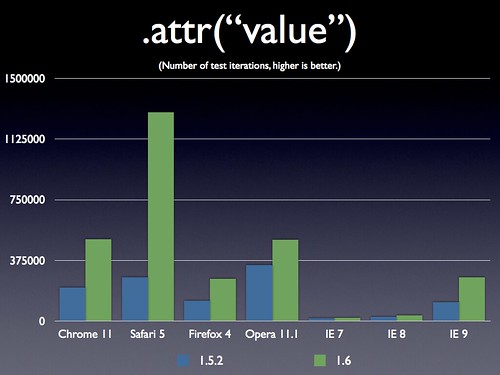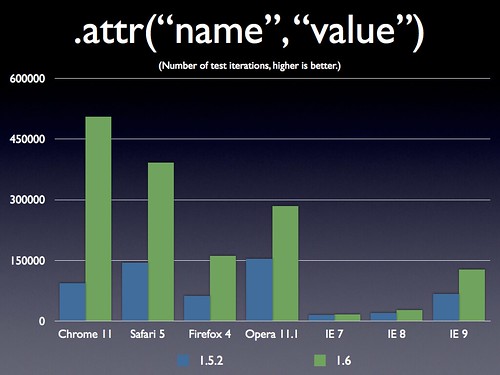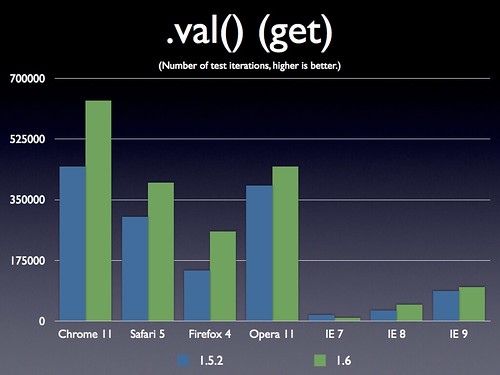We’re pleased to announce the first update to jQuery 1.6!
You can get the code from the jQuery CDN:
- jQuery 1.6.1 Minified and Gzipped (Use in production)
- jQuery 1.6.1 Uncompressed (Use for testing)
Additionally you can also load the URLs directly from Microsoft and Google’s CDNs:
Microsoft CDN: http://ajax.aspnetcdn.com/ajax/jQuery/jquery-1.6.1.min.js
Google CDN: https://ajax.googleapis.com/ajax/libs/jquery/1.6.1/jquery.min.js
You can help us by dropping that code into your existing application and letting us know that if anything no longer works. Please file a bug and be sure to mention that you’re testing against jQuery 1.6.1.
We want to encourage everyone from the community to try and get involved in contributing back to jQuery core. We’ve set up a full page of information dedicated towards becoming more involved with the team. The team is here and ready to help you help us!
Upgrading From 1.5.2 to 1.6.1
With the introduction of the new .prop() method and the changes to the .attr() method, jQuery 1.6 sparked a discussion about the difference between attributes and properties and how they relate to each other. It also came with some backwards compatibility issues that have been fixed in 1.6.1. When updating from 1.5.2 to 1.6.1, you should not have to change any attribute code.
Below is a description of the changes to the Attributes module in jQuery 1.6 and 1.6.1, as well as the preferred usage of the .attr() method and the .prop() method. However, as previously stated, jQuery 1.6.1 will allow you to use .attr() just as it was used before in all situations.
Note that the changes described in the 1.6 release notes regarding the .data() method have been worked around and now work seamlessly between 1.5.2 and 1.6.1.
What’s Changed
The changes to the Attributes module removed the ambiguity between attributes and properties, but caused some confusion in the jQuery community, since all versions of jQuery prior to 1.6 have handled attributes and properties in one method(.attr()). The old .attr() method had many bugs and was hard to maintain.
jQuery 1.6.1 comes with several bug fixes as well as an update to the Attributes module.
Specifically, boolean attributes such as checked, selected, readonly, and disabled in 1.6.1 will be treated just as they used to be treated in jQuery versions prior to 1.6. This means that code such as
$(“:checkbox”).attr(“checked”, true); $(“option”).attr(“selected”, true); $(“input”).attr(“readonly”, true); $(“input”).attr(“disabled”, true);
or even:
if ( $(“:checkbox”).attr(“checked”) ) { /* Do something */ }
will not need to be changed in 1.6.1 in order to work as previously expected.
To make the changes to .attr() in jQuery 1.6 clear, here are some examples of the use cases of .attr() that worked in previous versions of jQuery that should be switched to use .prop() instead:
.attr() |
Proper .prop() usage |
|---|---|
| $(window).attr… | $(window).prop… |
| $(document).attr… | $(document).prop… |
| $(“:checkbox”).attr(“checked”, true); | $(“:checkbox”).prop(“checked”, true); |
| $(“option”).attr(“selected”, true); | $(“option”).prop(“selected”, true); |
First, using the .attr() method on the window or document did not work in jQuery 1.6 because the window and document cannot have attributes. They contain properties (such as location or readyState) that should be manipulated with .prop() or simply with raw javascript. In jQuery 1.6.1, the .attr() will defer to the .prop() method for both the window and document instead of throwing an error.
Next, checked, selected, and other boolean attributes previously mentioned are receiving special treatment because of the special relationship between these attributes and their corresponding properties. Basically, an attribute is what you see in the html:
<input type=”checkbox” checked=”checked”>
Boolean attributes such as checked only set the default or initial value. In the case of a checkbox, the checked attribute sets whether the checkbox should be checked when the page loads.
Properties are what the browser uses to keep track of the current values. Normally, properties reflect their corresponding attributes (if they exist). This is not the case with boolean attributes. Boolean properties stay up to date when the user clicks a checkbox or selects an option in a select element. The corresponding boolean attributes do not. As was stated above, they are used by the browser only to store the initial value.
$(“:checkbox”).get(0).checked = true;
// Is the same as $(":checkbox:first").prop(“checked”, true);
In jQuery 1.6, setting checked with
$(“:checkbox”).attr(“checked”, true);
would not check the checkbox because it was the property that needed to be set and all you were setting was the initial value.
However, once jQuery 1.6 was released, the jQuery team understood that it was not particularly useful to set something that the browser was only concerned with on page load. Therefore, in the interest of backwards compatibility and the usefulness of the .attr() method, we will continue to be able to get and set these boolean attributes with the .attr() method in jQuery 1.6.1.
The most common boolean attributes are checked, selected, disabled, and readOnly, but here is a full list of boolean attributes/properties that jQuery 1.6.1 supports dynamically getting and setting with .attr():
autofocus, autoplay, async, checked, controls, defer, disabled, hidden, loop, multiple, open, readonly, required, scoped, selected
It is still recommended that .prop() be used when setting these boolean attributes/properties, but your code will continue working in jQuery 1.6.1 even if these use cases are not switched to use the .prop() method.
Below is a list of some attributes and properties and which method should normally be used when getting or setting them. This is the preferred usage, but the .attr() method will work in all attribute cases.
Note that some DOM Element properties are also listed below – but will only work with the new .prop() method.
| Attribute/Property | .attr() |
.prop() |
|---|---|---|
| accesskey | ✓ | |
| align | ✓ | |
| async | ✓ | ✓ |
| autofocus | ✓ | ✓ |
| checked | ✓ | ✓ |
| class | ✓ | |
| contenteditable | ✓ | |
| defaultValue | ✓ | |
| draggable | ✓ | |
| href | ✓ | |
| id | ✓ | |
| label | ✓ | |
| location * | ✓ | ✓ |
| multiple | ✓ | ✓ |
| nodeName | ✓ | |
| nodeType | ✓ | |
| readOnly | ✓ | ✓ |
| rel | ✓ | |
| selected | ✓ | ✓ |
| selectedIndex | ✓ | |
| src | ✓ | |
| style | ✓ | |
| tabindex | ✓ | |
| tagName | ✓ | |
| title | ✓ | |
| type | ✓ | |
| width ** | ✓ |
* For example, with window.location
** If needed over .width()
Neither .attr() nor .prop() should be used for getting/setting value. Use the .val() method instead (although using .attr(“value”, “somevalue”) will continue to work, as it did before 1.6).
Summary of Preferred Usage
The .prop() method should be used for boolean attributes/properties and for properties which do not exist in html (such as window.location). All other attributes (ones you can see in the html) can and should continue to be manipulated with the .attr() method.
jQuery 1.6.1 Change Log
The current change log of the 1.6.1 release.
Attributes
- #9071: $(‘<option></option>’).val(‘myValue’) no longer sets value
- #9079: .attr(“selected”) returns non-useful value in 1.6
- #9089: 1.6 atrr() Inconsistant in IE7,8
- #9094: Issue with jQuery 1.6: Can’t uncheck checkboxes
- #9103: .attr(‘foo’, true) not setting related DOM property
- #9123: Strange behavior of attr method when generate input element.
- #9129: jQuery does not support enumerated attributes such as contenteditable
- #9191: attr checked bug on radio
Data
Deferred
- #9104: Returning null or undefined in a pipe filter function causes an exception
Effects
- #9074: Cannot animate position and opacity at same time
- #9100: Order of hide() callbacks has changed
Event
- #9069: when hover over a child of an element, mouseleave fires when using live or delegate
Manipulation
Queue
- #9147: Variable tmp in promise implicitly declared?
Selector
- #7341: Slow .add() in IE
- #9096: Selector or find bug in jQuery 1.6
- #9154: :reset pseudo-selector broken






 What started, with great demand, at the San Francisco Bay Area conference last year and has continued on for the conferences thereafter is our preconference training. We are once again offering preconference training on April 15
What started, with great demand, at the San Francisco Bay Area conference last year and has continued on for the conferences thereafter is our preconference training. We are once again offering preconference training on April 15 Bocoup gave a bunch of advanced and hack day training classes in Boston last year in addition to the preconference Introduction to jQuery class, which also was greatly attended. We are very happy to announce that Bocoup will once again be giving the Introduction to jQuery class.
Bocoup gave a bunch of advanced and hack day training classes in Boston last year in addition to the preconference Introduction to jQuery class, which also was greatly attended. We are very happy to announce that Bocoup will once again be giving the Introduction to jQuery class. New this year is an additional track for Advanced jQuery and we are happy to have Jupiter JavaScript Consulting give this class. JuptierJS builds and maintains JavaScriptMVC and has plenty of experience building complex jQuery apps.
New this year is an additional track for Advanced jQuery and we are happy to have Jupiter JavaScript Consulting give this class. JuptierJS builds and maintains JavaScriptMVC and has plenty of experience building complex jQuery apps.